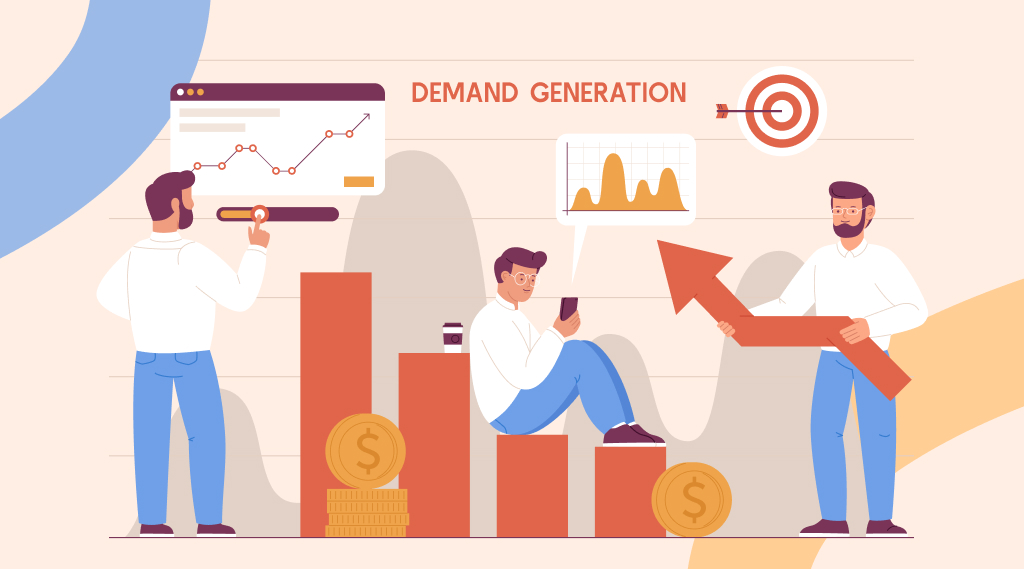Introduction
Demand generation is the process of creating and nurturing fresh possibilities for the sales team. By increasing marketing expenditures, a robust demand generation program enables the business to increase the number of possibilities it sources each month or quarter (e.g., invest $1, receive $3 in return).
Generating demand between businesses is a business strategy. Its objective is to increase interest and awareness of your offering. It includes all of the interactions a potential customer has with your company, including how they initially come across you, how they grow to love your brand, how they educate themselves about your product (on their own schedule), and how they finally become qualified leads and join your sales funnel.
What are the different types of demand generation?
Many people can increase demand in a variety of ways. Therefore, it’s critical to comprehend the many strategies available before launching into demand generation.
1. Inbound demand generation
To create a pipeline, inbound demand generation combines the most successful elements of inbound marketing with a successful purchasing process. Completely anonymous buyers are guided from exploration to choice by inbound demand generation.
Among the strategies employed in inbound demand generation are:
- Blogs
- Social media information that has been tailored for in-feed viewing
- live performances
- Audio podcasts
2. Outbound demand generation
While outbound demand generation centres on pipeline construction, buyer disruption is achieved through interruption-based tactics. Without their express consent, a message is forced upon them. Depending on their use, outbound strategies consist of:
- bulk email
- Making cold calls
- By mail
- Purchasing information
- Intent information
5 components of an effective B2B demand generation strategy
1. Recognize the position of your company
First and foremost, you must be well aware of your company’s value proposition and how your offering compares to competitors. Understanding who needs your solution allows you to determine its worth.
2. Recognize your target
The next stage is identifying the personas in the companies you want to interact with and your ideal client. As a result, you may adjust your content strategy to focus more on your audience’s needs than on your company’s.
3. Content planning
A key component of creating inbound demand is content. Potential customers cannot self-discover, self-educate, or self-select possible suppliers without it. You must carefully organise, organise, and craft your material if you want to produce information that appeals to potential customers.
4. The channel plan
Once you have a content creation strategy in place, you must decide which channels to employ and how to disseminate the material. As an illustration:
- LinkedIn is going to be the platform we use to share in-feed material.
- To bid on keywords with buyer intent, we will employ PPC.
- We are going to use blogging to focus on keywords related to schooling.
- Our live events will be streamed live on YouTube.
5. Optimization of conversion
Making sure customers can efficiently assess your offering, respond to important inquiries regarding purchases, contrast it with rivals, and promote high-intent conversions is the goal of conversion optimization. Generally, this begins with your website in B2B situations.
- For potential customers to find you, your website must be easily navigable.
- In order for your customer to know where to find information on your website and how to contact you, you must provide a clear user experience.
- A quick and easy sales procedure that considers your customer’s requirements is essential.
The best demand generation software
HubSpot
HubSpot is a platform that includes CRM, websites, marketing, sales, and support, and it has many applications for creating demand. You can use any or all of the HubSpot capabilities to enhance your demand generation campaigns.
1. CRM HubSpot
In order for all of your commercial functions to be in sync with a single source of truth, it is imperative that you have a clear, unified view of your contacts. This not only improves the efficiency of your revenue operations, but it also makes it possible for all commercial teams to report success using the same data. G2 has ranked HubSpot CRM as the best CRM, and with good reason.
2. 6Sense
Since the black funnel accounts for 70% of the buyer’s journey, 6sense Revenue AI assists you in identifying anonymous buying signals, identifying and targeting the right accounts at the ideal moment, and optimising revenue performance by suggesting the channels and messages that are most likely to result in a conversion.
3. Wynter
Measurement of messaging in marketing is challenging and typically requires educated guesswork. With Wynter, you can gauge how well your preferences and messaging work.
What is the role of sales in demand generation?
The B2B buyer experience has changed; buyers now spend more time conducting independent research and far less time with sales representatives.
Sales teams must adapt their approach in order to effectively service their buyers in light of the shifting preferences of their customers. With a few notable deviations, the inbound sales process is primarily followed when selling through a demand creation plan. This strategy emphasises a consultative process to fully comprehend the problems faced by the customers and demonstrate how your solution may address them.
These are the main distinctions between a demand generation sales approach and a standard sales approach.
1. Traditional sales strategy
- Use outbound techniques like LinkedIn InMails and email blasts to reach potential customers unfamiliar with your brand.
- Try pitching sequences to buyers who have downloaded gated content.
- Employ messaging that is specific to the qualities and attributes of the product.
- Start with pamphlets with the same details that consumers may get online.
- attempting to sell despite the buyer’s poor fit at all costs.
2. Demand generating sales strategy
- It has minimal outbound activity and prioritises speaking with customers who have clarified their interests.
- Consultation-based advice is the only message that is sent out. The buyer cannot discover customised information anywhere but in presentations and collateral.
- It is more important to explain how your solution meets the needs of the buyer than why it doesn’t.
B2B Demand Generation Channels
A demand generation strategy’s ability to generate traffic and leads depends on the channels chosen. The ROI of a channel will vary depending on the target industry and sector.
Most often used demand generating platforms are: – Google Ads – LinkedIn Ads – Facebook Ads (for retargeting)
- Google Ads
- LinkedIn Ads
- Facebook Ads (for retargeting)
- Email marketing
- Content syndication
- Quora Ads
- Search Engine Optimization (SEO)
- Direct mail
- Trade Shows/Conferences
- Sponsored webinars
The secret is to launch tiny test campaigns across various channels and then scale the most profitable ones. Remember that monitoring each marketing touch in the B2B funnel is critical. While some channels will work better as first-touch marketing, others (last-touch initiatives) will be more successful at turning leads into paying clients.
Conclusion
In B2B SaaS, demand generation is essential to long-term growth. You can fully use demand generation to drive leads, conversions, and eventually commercial success by knowing your audience, using targeted techniques, and embracing continual optimization. Put these tactics into practice right now, and you’ll see your SaaS company prosper in the cutthroat market.


